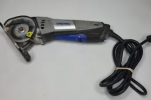Northsider
Modelling the Northern half of the Isle of Man
[QUOTE="3 minutes of fame, post: 695542, member: ]
Eye protection is a must. It's not only if a disc was to fail - it can happen, but also the dust and metal filings that fly off during cutting.
[/QUOTE]
Absolutely. Putting on a pair of safety specs (correctly rated for impact protection) should be automatic. Hefty gloves too, for larger discs.
Eye protection is a must. It's not only if a disc was to fail - it can happen, but also the dust and metal filings that fly off during cutting.
[/QUOTE]
Absolutely. Putting on a pair of safety specs (correctly rated for impact protection) should be automatic. Hefty gloves too, for larger discs.


